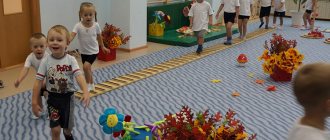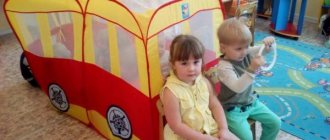Fire safety in preschool educational institutions
Compliance with fire safety is one of the key points in the system of ensuring the safety conditions of a preschool institution.
Firstly, you should pay close attention to the fire safety of the building: conduct periodic inspections of gas stoves in the kitchen and electrical wiring throughout the building. The premises of the preschool educational institution must be equipped with basic means of fire protection: fire extinguishers, shovels and sand. It is necessary to have a “panic button” in the building, with which you can quickly call the fire brigade or the Ministry of Emergency Situations.
Secondly, you should pay close attention to the objects with which the child plays. After all, the presence of matches or a lighter in the hands of a baby is not necessarily caused by the negligence of the parents - it may be an accidental discovery of a young researcher who will probably want to figure out “how it works.”
Persons responsible for the safety of children
Almost every parent asks the question: who is responsible for the safety of their precious child in a preschool? From the point of view of the structure of the educational institution, the number one responsible person and the one who ensures safety checks on the territory of the preschool educational institution is the director or head of the kindergarten. As the main document of any educational institution states (the Law “On Education”), the head is personally responsible for the safety of each of his students.
Of course, it is impossible for the head of a preschool educational institution to keep track of several dozen children at once, so the group teacher becomes responsible for ensuring the safety of the child in the kindergarten.
The child's parents can also make an invaluable contribution to ensuring the baby's safety. As a rule, this is voluntary financial and material assistance to the kindergarten, aimed at updating outdated elements of playgrounds, desks, cribs and other structures. It is also the task of parents to monitor compliance with safety standards in the garden. All these are important steps to ensure the safety of the children of the preschool institution and, first of all, your beloved baby.
What dangers await the baby?
Children can face a variety of dangers on the territory of the kindergarten. Several categories can be distinguished:
- increased morbidity.
This is probably the most common danger factor encountered in preschool institutions. It's no secret that kindergarten is a place with a large concentration of children of different ages. And it is quite natural that children have different immunity and susceptibility to diseases. Therefore, it is hardly surprising that in kindergarten a child often “catch” various infections and diseases. This is especially concerning for parents whose children have weakened immune systems; - injuries, accidents
. The causes of injuries can be very different: children can often injure each other in the struggle for toys, push away friends while rushing from a walk to lunch, fall out of the crib during an afternoon nap, or carelessly ride down a slide - there can be a great many sources of injury; - emergencies.
Although such phenomena as fire and earthquakes are infrequent events, and we live in peacetime, we should not forget about the necessary measures to prevent such situations and the principles of ensuring safety during emergencies. - threat to the child's psychological health
. Not all parents think about the fact that their child in kindergarten can be harmed not only physically, but also psychologically. And this is due to several factors: personal characteristics of the staff, manipulation of children, relationships between children, stress when parting with their mother. Parents need to monitor the psychological state of the child, and when a child categorically refuses to go to kindergarten, they should carefully understand the reasons.
Factors for ensuring safety in kindergarten
To protect children from various dangers, thereby keeping babies healthy and parents happy, a preschool must ensure that many safety factors are observed.
One of the most important factors is the safety of children's health
. In order to prevent various colds and infectious diseases, the garden premises must be maintained at an appropriate temperature, as well as the level of lighting and ventilation. Also, in places where children are located, there must be no drafts.
Regular medical examination of facility staff is mandatory to exclude infectious diseases. An educational institution must have a nurse on staff who constantly monitors the health and condition of children and is responsible for calling an ambulance, if necessary. Periodic examinations of young pupils in professional medical institutions are also mandatory.
It is important to monitor the sanitary condition of the preschool educational institution, and, most importantly, the kitchen and children’s food. For children who are prone to allergic reactions to certain foods, it is necessary to develop an individual menu. In this case, greater responsibility falls on the parents. You cannot remain silent about allergenic products, as information about them may not be in the child’s medical record.
It is mandatory to carry out daily cleaning and periodic disinfection in the kindergarten premises, and all participants in the educational process must strictly respect the rules of personal hygiene.
Among the key safety factors is the physical safety of children. To ensure this, a set of conditions must be created in the kindergarten to ensure the protection of the life and health of children. The threat can be caused not only by external (criminal, terrorist acts, insane actions of adults), but also internal (inadequate technical condition of the building and structures on its territory) factors.
In order to avoid accidents, the technical condition of the premises and adjacent buildings must be subject to mandatory regular monitoring. In addition, each kindergarten employee must have instructions on how to interact with the main security services. At the same time, a mechanism for interaction with such organizations must not only be developed, but also tested in practice in educational settings. The best way to train behavior skills in emergency situations is to periodically (at least twice a year) conduct training evacuations from the premises and territory of the preschool educational institution.
To avoid the kidnapping of children from the kindergarten, children can only be given to their mothers and fathers, and when other people come to the kindergarten, written permission from the parents is required.





